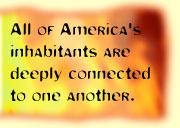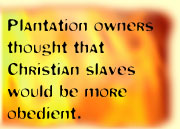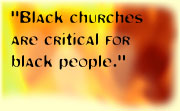

Tripod Home | New | TriTeca | Work/Money | Politics/Community | Living/Travel | Planet T | Daily Scoop
|
POLITICS & COMMUNITY

by Andre C. Willis Published July 18, 1996 Part Two of this series concerns the consequences of the arsonists' actions. |
Recently, American-style disdain and disregard for black life has manifested in incidents of arson at over seventy black churches in the South. There are a number of complicated reasons for these church burnings, yet, what is most important about these tragic occurrences is not the sanity of the arsonists, the particular reasons the fires were set, the state of the church buildings, the costs of the fires, or even the well-being of the individuals who use the churches. What is most important is that these arsons symbolize the profound degree to which America has not been able to successfully affirm the fact that all of its inhabitants are deeply connected to one another. When we begin to understand the common heritage and common fate of all races of Americans as fundamental, instead of using racial difference as a means to suggest -- as white supremacy does -- that whites are better, more humane, and more worthy than blacks, then we will less likely face the race based hatred and venom that these arsons represent.
|

|
The church burnings have outraged Americans across the racial fault lines, yet many black people feel particularly attacked because of the highly unique role of the Black Church. Due to its historic position as a place of racial refuge and social resistance, the Black Church has a different significance to black people than the 'White Church' does to white people. Black churches are critical places for black people not only for spiritual sustenance, but also because they are the most visible evidence of black institutionalization, black autonomy, and, therefore, black power that African-Americans, collectively, have. The Black Church, no matter how problematic its programming, politics, and theology, is the only site black people have which is relatively safe from the assault by white supremacy and the only institutional space which allows for black people to be comfortable enough to be themselves.
|

A list of burned black churches from the Washington Post. |
While no one can argue conclusively why these tragic church burnings have occurred, once we examine the history of the Black Church these burnings take on a new significance. Many scholars contend that the initial impetus behind the Black Church was the fact that many Africans were not allowed to practice their indigenous faiths during the colonial slave era. Christianity, as presented to them by white slave owners and preachers, was the only religion that slaves could practice and it was a version of Christianity which, based on white interpretation, ordained slavery. To ensure black slaves would not question their status as slaves, white missionaries heavily emphasized the following three interpretations in the transmission of Christianity to the African slaves:
|

Read about Andre C. Willis and his new book in the Tripod interview. |
Despite these emphases, many African slaves in America embraced Christianity. But they applied a profoundly different interpretation of the Gospel -- one that emphasized the liberating political and spiritual power of Jesus, the freeing of the slaves by Moses in the Old Testament, and a rejection of Paul's letters as being incompatible with the ethic of equality that Jesus taught. Although it was illegal for blacks to assemble in groups, many slaves would gather before dawn on Sunday to feel the liberating power of the Gospel. These gatherings, labeled 'The Invisible Institution', affirmed the possibilities of black freedom and provided communal moments of transcendence. They formed the foundation of the Black Church and thereby laid the groundwork of the movement for black freedom.
The independent Black church movement was not only a move for black autonomy, but also a critique of white churches. Early Black churches started on plantations with the consent of the plantation owners who frequently thought that slaves who were saved would be more obedient than those who were not saved. The first all black congregation on record was organized in 1758 in what is now called Mecklenburg, Virginia. Another early Black Baptist Church was founded in 1774 in Silver Bluff, South Carolina, with churches in Williamsburg and Petersburg, Virginia being organized in 1776. In 1785, Richard Allen and Absalom Jones led black people to walk out as a protest of the racism in St. George's Methodist Episcopal Church in Philadelphia. In 1816, they would begin the first black denomination - The African Methodist Episcopal Church. As a result of these efforts the Black Church became the first national institution created, controlled and sustained by African-Americans.
Andre C. Willis is an assistant professor at the Center for Interdisciplinary and Special Studies at College of the Holy Cross in Worcester, MA. He is the editor of "Faith of Our Fathers," a collection of essays by eminent African-American men reflecting on fatherhood. © 1996 Tripod, Inc. All Rights Reserved.

|
Map | Search | Help | Send Us Comments